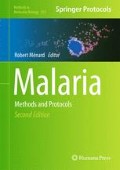Abstract
Exoerythrocytic Plasmodium parasites infect hepatocytes and develop to huge multinucleated schizonts inside a parasitophorous vacuole. Finally, thousands of merozoites are formed and released into the host cell cytoplasm by complete disintegration of the parasitophorous vacuole membrane. This, in turn, results in death and detachment of the infected hepatocyte, followed by the formation of merosomes. The fast growth of the parasite and host cell detachment are hallmarks of liver stage development and can easily be monitored. Here, we describe how to translate these observations into assays for characterizing parasite development. Additionally, other recently introduced techniques and tools to analyze and manipulate liver stage parasites are also discussed.
Access this chapter
Tax calculation will be finalised at checkout
Purchases are for personal use only
References
Amino R et al (2006) Quantitative imaging of Plasmodium transmission from mosquito to mammal. Nat Med 12:220–224
Bano N et al (2007) Cellular interactions of Plasmodium liver stage with its host mammalian cell. Int J Parasitol 37:1329–1341
Sturm A et al (2009) Alteration of the parasite plasma membrane and the parasitophorous vacuole membrane during exo-erythrocytic development of malaria parasites. Protist 160:51–63
Graewe S et al (2011) Hostile takeover by Plasmodium: reorganization of parasite and host cell membranes during liver stage egress. PLoS Pathog 7:e1002224
Stanway RR et al (2009) GFP-targeting allows visualization of the apicoplast throughout the life cycle of live malaria parasites. Biol Cell 101:415–430
Sturm A et al (2006) Manipulation of host hepatocytes by the malaria parasite for delivery into liver sinusoids. Science 313:1287–1290
Baer K et al (2007) Release of hepatic Plasmodium yoelii merozoites into the pulmonary microvasculature. PLoS Pathog 3:e171
Friesen J et al (2010) Natural immunization against malaria: causal prophylaxis with antibiotics. Sci Transl Med 2:40ra49
Helm S et al (2010) Identification and characterization of a liver stage-specific promoter region of the malaria parasite Plasmodium. PLoS One 5:e13653
Stanway RR et al (2011) Organelle segregation into Plasmodium liver stage merozoites. Cell Microbiol 13:1768–1782
Janse CJ et al (2006) High-efficiency transfection and drug selection of genetically transformed blood stages of the rodent malaria parasite Plasmodium berghei. Nat Protoc 1:346–356
Stanway RR et al (2009) Highly efficient subcloning of rodent malaria parasites by injection of single merosomes or detached cells. Nat Protoc 4:1433–1439
Acknowledgments
Paul-Christian Burda is thanked for providing the images of Fig. 1. All members of the AG malaria I at the Bernhard Nocht Institute in Hamburg and the malaria Lab at the Institute of Cell Biology in Bern are thanked for their valuable input in developing the described methods. Financial support came from the DFG (SFB 841: VH4497/1-2 and SPP 1399: VH4497/1-3) and the EU consortia Malsig and EVIMalaR.
Author information
Authors and Affiliations
Corresponding author
Editor information
Editors and Affiliations
Rights and permissions
Copyright information
© 2012 Springer Science+Business Media, LLC
About this protocol
Cite this protocol
Stanway, R.R., Schmuckli-Maurer, J., Heussler, V.T. (2012). Analysis of Liver Stage Development in and Merozoite Release from Hepatocytes. In: Ménard, R. (eds) Malaria. Methods in Molecular Biology, vol 923. Humana Press, Totowa, NJ. https://doi.org/10.1007/978-1-62703-026-7_29
Download citation
DOI: https://doi.org/10.1007/978-1-62703-026-7_29
Published:
Publisher Name: Humana Press, Totowa, NJ
Print ISBN: 978-1-62703-025-0
Online ISBN: 978-1-62703-026-7
eBook Packages: Springer Protocols

